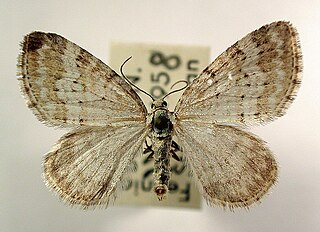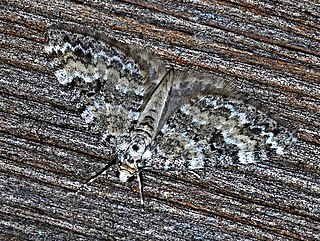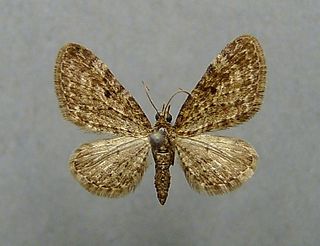
Perizoma flavofasciata, the sandy carpet or sandy rivulet, is a moth of the family Geometridae. The species was first described by Carl Peter Thunberg in 1792. It is found in most of Europe and northern Africa and east across the Palearctic to the Urals and the Altai Mountains. The species prefers meadow valleys, floodplains, waterside areas, bushy meadows and gardens. In the Alps it rises to 1500 metres.

Perizoma albulata, the grass rivulet, is a moth of the genus Perizoma in the family Geometridae. The species was first described by Michael Denis and Ignaz Schiffermüller in 1775.

Euchalcia consona is a moth of the family Noctuidae. It is found in Europe from Austria, through Hungary and Siberia up to the Ural mountains.

Perizoma is a genus in the geometer moth family (Geometridae). It is the type genus of tribe Perizomini in subfamily Larentiinae. The tribe is considered monotypic by those who include the genera Gagitodes, Martania and Mesotype in Perizoma. Some other less closely related species formerly placed here are now elsewhere in the Larentiinae, e.g. in Entephria of the tribe Larentiini.

Gagitodes sagittata, the marsh carpet, is a moth of the family Geometridae. The species was first described by Johan Christian Fabricius in 1787. It is found in eastern Asia, including Japan, Korea and China and in central and northern Europe. It is sometimes included in the genus Perizoma

Agrotis simplonia is a moth of the family Noctuidae. It is found in the Alps, Pyrenees, the Cantabrian Mountains and the Apennine Mountains on heights between 1,200 and 3,000 meters.

Mesotype didymata, the twin-spot carpet, is a moth of the family Geometridae. The species was first described by Carl Linnaeus in his 1758 10th edition of Systema Naturae. Its genus is sometimes included in Perizoma.

Xestia ochreago is a moth of the family Noctuidae.

Mesotype parallelolineata is a moth of the family Geometridae, subfamily Larentiinae. The species was first described by Anders Jahan Retzius in 1783. It is found in most of Europe, from central Europe through Russia to the Ural and Altai Mountains. Its genus Mesotype is sometimes included in Perizoma.

Perizoma affinitata, the rivulet, is a species of moth of the family Geometridae. It was first described by James Francis Stephens in 1831 and it is found in most of Europe.

Perizoma blandiata, the pretty pinion, is a moth of the family Geometridae. The species was first described by Michael Denis and Ignaz Schiffermüller in 1775. It is found from most of central and northern Europe to central Asia as far as the Khangai Mountains.

Perizoma hydrata is a species of moth of the family Geometridae. It is found from most of Europe and the Caucasus through western Siberia to the Sayan Mountains and Altai and northern Mongolia.

Perizoma minorata, the heath rivulet, is a moth of the family Geometridae. The species was first described by Georg Friedrich Treitschke in 1828.

Pungeleria capreolaria is a moth of the family Geometridae. It is found in the mountains of southern Europe, as well as on the Balkan Peninsula and the Caucasus.

Perizoma obsoletata is a species of moth of the family Geometridae. It is found in the Pyrenees, the Massif Central, the Apennine Mountains, on Corsica, in the Alps and Swiss Prealps, the Jura Mountains, the Black Forest, the Swabian Jura, the Sudetes, the High Tatras, the Carpathian Mountains and the mountains of the Balkan Peninsula.

Cataclysme riguata is a moth of the family Geometridae. It is found from the Iberian Peninsula through western and central Europe to the mountains of Central Asia.

Eupithecia silenata is a moth of the family Geometridae. It is found in the mountainous areas of central and southern Europe, in the east, the range extends to the Krkonoše mountains and the Caucasus.

Gnophos furvata is a species of moth in the family Geometridae. It is found in southern and central Europe. In the east, the range extends to the Carpathian Mountains and Ukraine.

Lamprosticta culta is a moth of the family Noctuidae. It is found from the Pyrenees to Ukraine and in Turkey.
Eupithecia carpophagata is a moth in the family Geometridae. It is found in the mountains of Europe, including the eastern Pyrenees, the central and southern part of the Alps, the Massif Central, the central Apennines and the Balkan Peninsula.



















